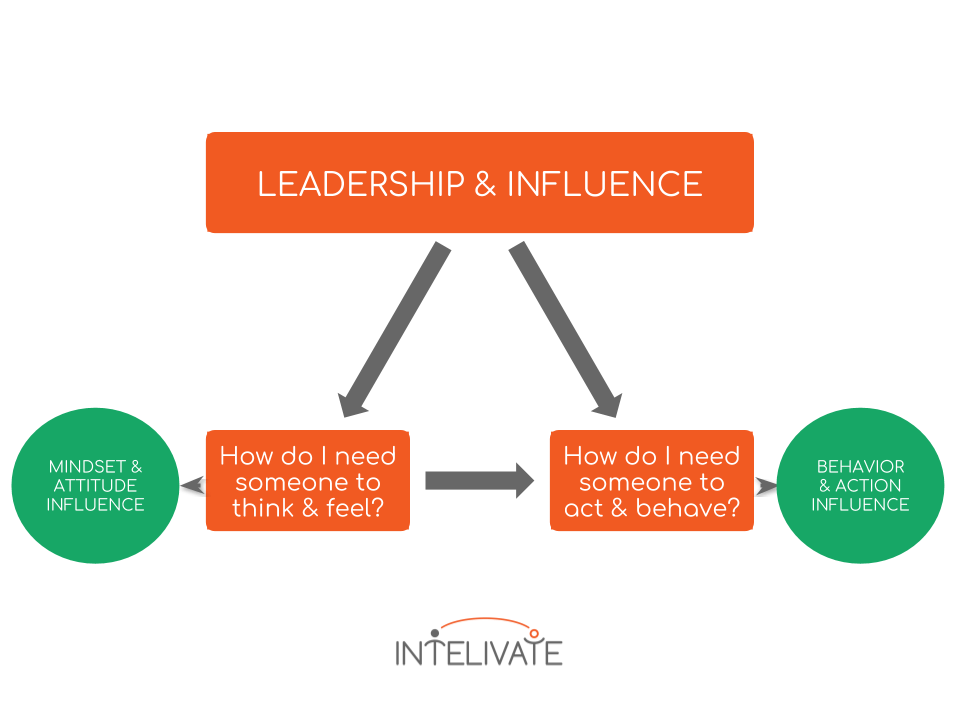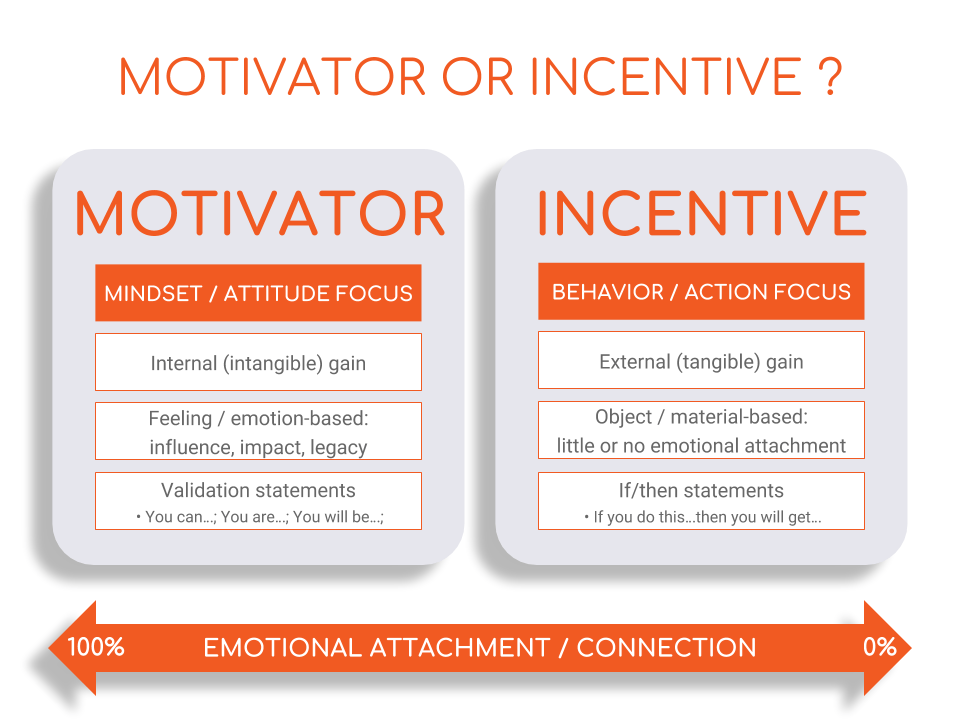Most leaders and organizations don’t understand the difference between motivators and incentives. Here are the major differences and when/how to use each.
I remember when I first started a team lead role. I would bring in doughnuts for the team. After slapping them down on the table, I would run to my office thinking I had just given the greatest motivator ever.
I was wrong.
Most of the team hated doughnuts and those that didn’t couldn’t eat them. Not only did my choice of motivator fail, it actually did more harm than good.
I’ve learned a lot in the 20 years since. Besides the gift of understanding when to manage versus lead, I’ve learned the key differences between motivators and incentives.
Incentives and Motivators are Used in Every Relationship
Negotiating happens in every relationship. Whether the relationship is with an employee, team, spouse or child, mastering negotiation and conflict management strategies are essential.
Every relationship also uses incentives and motivators. That sounds odd but think about it. Sometimes you use a motivator and other times you use an incentive to influence your desired end-result.
But are you using them at the right time and for the right reasons?
Understanding the differences between incentives and motivators begins with first understanding the basics of leadership and influence.
The Basics of Leadership and Influence
The function of leadership is influencing people towards a desired attitude and behavior. The goals and individual you are leading determine the desired attitudes and behaviors.

When influencing a person’s mindset and attitude, the first question you must answer is:
How do I need this person to think and feel?
This can be incredibly difficult depending on the person and situation but is imperative for success in influence. Why? You want to use that desired attitude to feed into the desired behavior. That’s when you need to answer the question:
How do I need someone to act and behave?
You’ll soon realize that understanding whether you need to focus primarily on influencing attitude or behavior determines whether you should use motivators or incentives.
Let’s start with motivators.

What are Motivators?
Motivators develop feelings of worth or enthusiasm towards something or someone. The gain obtained by a motivator is primarily internal or intangible and is often developed through validation statements and feelings of worth and accomplishment. These statements and feelings of value are either internally developed or externally accepted.
A pure motivator has nearly a 100% emotional attachment and connection.
Identifying Motivators
Although typical motivators are universal amongst groups and individuals, the effective use of motivators requires identifying specific priorities at the individual level.
How do you do this in any relationship? Really get to know the person to identify specific motivators. Here are some areas to understand at the individual level to understand a person’s motivators:
- What makes them happy?
- What are their goals?
- What scares them?
- Who is important to them?
Example of Using Motivators
Whenever I conduct a leadership training and coaching on developing influence, I use the situation of getting your child to clean his room.
If satisfying you – his parent – is a priority, then effective motivator statements might be:
You really make me proud when you clean your room!
You’ve helped me so much by cleaning your room. Thank you!
I can’t tell you how happy it makes me when you clean your room!
If a feeling of accomplishment is more important to the child, then effective motivator statements might be:
Wow, you really do an incredible job cleaning your room!
I don’t think I’ve ever seen a room this clean before – great job!
Your room is so clean! Will you show me how you do such a great job?!
Remember – one of the ways to identify motivators is by understanding an individual’s fears. A motivator is also used to avoid a fear. Is your child afraid of disappointing you? If so, then a ‘negative’ motivator might be:
It really disappoints me when I have to ask you to clean your room.
I know you can do a better job than this when it comes to cleaning your room.
Your mom won’t be happy if she sees your room like this.
Yes, the example is simplistic but that’s the point. It shows you an everyday life example of using motivators in two different ways – positive and negative.
When and How to Use Employee Motivators
Motivators primarily influence the mindset and attitude portions of leadership. When you need to do some attitude adjustment, a motivator is most effective.
For long-term sustainability of mindsets and behaviors you are influencing, motivators should be your primary focus.
Why?
They build a more lasting internal feeling of worth and accomplishment and eventually leads to a more consistent display of desired behaviors. The effective use of motivators builds self-accountability and self-motivation.
Because the right attitude is there, you eventually don’t have to chase after the desired behaviors.
The consistent use of an effective motivator is critical because consistency is one of the primary ways to build trust in a team and overall validation.

What are Incentives?
Incentives are material based and offer external or tangible gains to a person. Examples might be money, a vacation, or prize.
The typical formula for delivering an incentive is:
If you do this, then I’ll give you that.
or
If you don’t do this, then I’ll take that away.
A pure incentive has nearly a 0% emotional attachment and connection.
That’s not to say that the incentive doesn’t invoke emotion. The emotion connects to something external, though.
Identifying Incentives
Incentives are usually easier to identify than motivators because they are more common. However, it is still imperative to individualize incentives as much as possible for the biggest impact.
Ask any of the same questions to determine individual incentives, but focus on the material gains that satisfy a person’s priorities.
Example of Using Incentives
I’ll use the same example of getting your kid to clean his room. Let’s assume you have neither the time nor desire to influence his attitude. You need the room cleaned quickly before company arrives.
Just as with a motivator, there are ways to use incentives in both a positive and negative way.
Positive incentives provide something not already expected.
If you do a great job cleaning your room, I’ll let you play an extra 30 minutues of video games.
You can have an extra cookie after you clean your room.
I’ll give you an additional $5 to your allowance if you clean your room now.
Negative incentives withdraw something already expected:
I’ll take your video games away from you for an entire week unless you clean your room now.
Unless you clean your room, you can’t have a cookie.
You won’t get your allowance unless you clean your room.
When and How to Use Employee Incentives
Incentives primarily influence the behavior and actions portions of leadership. When you need a quick change in behavior, an incentive is most effective.
Because incentives focus on more immediate results, they should be secondary to motivators for sustainability.
Why?
If you rely solely on an incentive for performance, you become dependent on the incentive. The incentive becomes expected over a period of time. If you remove the incentive, then the behavior stops.
People and organizations relying too heavily on incentives develop a “carrot culture.” You must constantly dangle the proverbial carrot in front of someone to get desired results Over time, the carrot must grow bigger and be dipped in mounds of chocolate to get the same results.

Balancing the Use of Incentives and Motivators
Now that you know more of the differences between incentives and motivators, the best approach for leveraging both is a balance. Don’t become too dependent on either.
Stay focused on long-term performance with motivators while leveraging incentives for short-term gains. Never use an incentive in place of a motivator as it will backfire just like my doughnut example.
Just as important to balancing, it is critical to personalize both. People need motivators and incentives at different times and for different reasons. Keep a pulse on each person and make sure you don’t rely too much on incentives as that’s an easy trap that you’ll find difficult to get out of in the long run.
Final Thoughts
Hopefully, this helped clear some of the confusion I see in the differences between an incentive and a motivator. If you have any questions or comments, let me know on Twitter or Facebook.
I’ll be doing another article soon on the proper use of formal incentive and recognition programs, so be sure to check back soon or subscribe below to be the first to get it! Here’s a hint – most organizations implement these programs incorrectly. It costs them a ton of money – and morale.
Related Solutions to Help With Your Team Motivators & Incentives
> Business & Team Leadership Strategy Solutions
Kris Fannin
Kris Fannin is a passionate change agent in workforce transformation. For more than 25 years, he's had the privilege of partnering with dozens of client organizations and leading hundreds of teams to become powerful influencers.
"Your legacy will be defined by the passion and impact of the people you influence. What do you want your legacy to be?"



